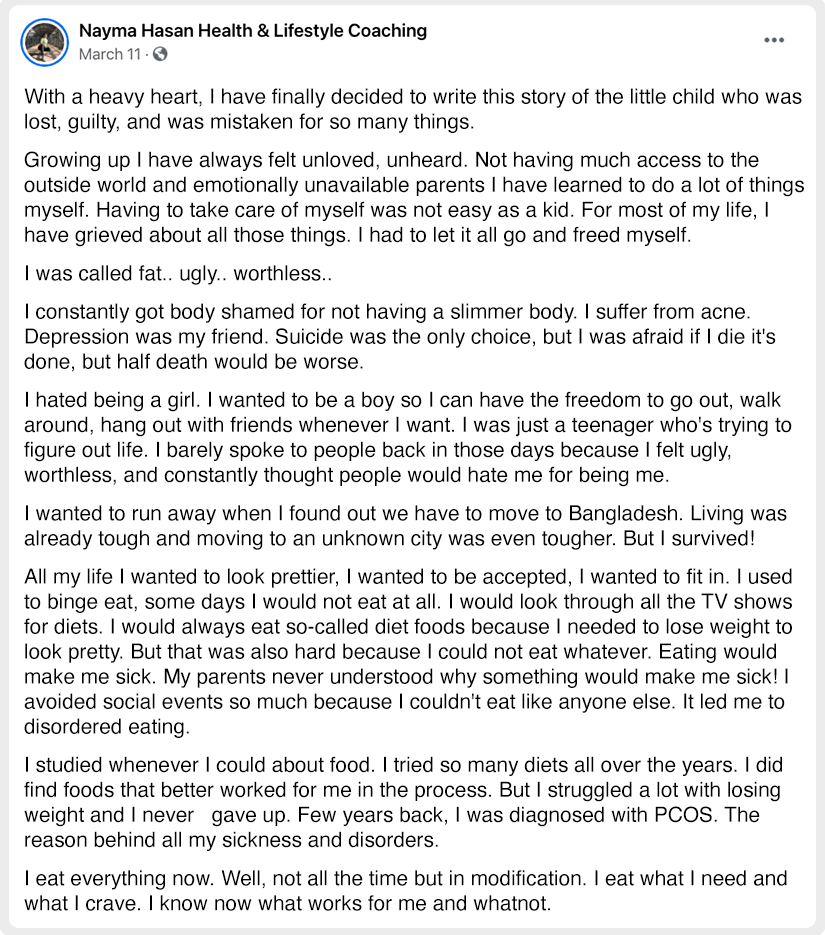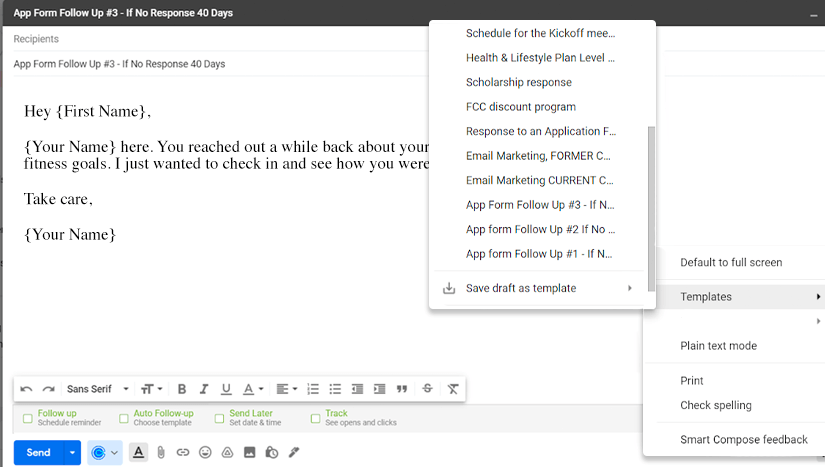A side hustle can change your life.
The extra income may mean you can take more trips, save up for a new car or house, or even cut back hours at your full-time job.
Still, running a successful side hustle isn’t easy, especially when you’re starting out.
Here's how Online Trainer Academy students successfully grew their fitness or nutrition side hustles while still working full-time.
Know you’re going to be really, really busy
It’s called a side hustle for a reason.
Gina Mauricio, an online marathon coach in San Diego, would wake up at 4 a.m., jump on her platform and check in with clients, work out, then commute to her day job as a dental hygienist.
“Between patients I was logging on the computer,” she says. “At lunch I was checking. Then after work I would hop on the computer again.”
On weekends, she’d be in front of the computer screen for 20 hours, writing all her programs and providing client feedback. She felt frustrated and tired, and was missing out on family time.
“We tend to put too much on our plates: ‘Oh, I can handle it. No big deal,’” Mauricio says. “But you don’t think about the little things, like birthdays and family commitments.”
Seeing her clients’ successes is what kept Mauricio going. “It was this labor of love,” she says. She powered through.
Nayma Hasan from Bangladesh, who started a nutrition coaching side hustle in January while working full-time in IT, diligently sticks to a schedule so she won’t fall behind.
She manages social media, email, and client messages in the morning, and takes calls in the evenings between 6 p.m. and 9 p.m.
Most important, she always takes Sundays off. She’ll put her phone away for the day and practice self-care: take a long bath, put on music and dance, or watch a movie or binge watch a TV series.
“I take time for myself,” she says, “so I feel fresh and ready to work the next day.”
Tell the world what you’re doing
Hasan got started last year when one of her friends reached out for help. “I started helping him and realized I could become a coach for real,” she says.
But then she faced a challenge: She wasn’t sure how to get more clients.
When she enrolled in the Online Trainer Academy in February, she learned she needed to be more proactive and let people know what she was doing.
So she started posting content about health and nutrition on her social media pages, positioning herself an expert.
Every day she interacts with at least five people who engage with her posts, asking their permission in the comments to message them directly. She starts conversations and, if the person is interested, tries to get them on the phone.
She also started posting in health-and-fitness-related Facebook groups, sharing her own transformation story. People saw her posts and reached out. (Learn how to share your story and connect with more clients.)

By following these simple practices, she’s been able to get 12 clients in five months.
Her side hustle now brings in double what she earns at her day job as a product specialist for a software firm, and she’s on track to leave her job and focus on coaching full-time in the next two months.
And get this: When she told her boss she’d be leaving and why, he told her he knows some people who might be interested in her service!
Clients are out there. Put yourself out there, and people will respond.
Use pockets of time in your workday wisely
Jim Gazzale has been a nutrition coach since 2017 and works full-time doing media and public relations for the state of New York. Every evening he maps out a game plan for the following day.
“I look at my meetings, deadlines, calls,” he says. “Wherever I see a gap, I make sure I’m ready to do something productive.”
He looks at his Google and iCal calendars on his phone, then grabs an old-fashioned pen and paper and writes down how he’ll fill the gaps.
“If the time gap is 30 to 60 minutes, I'll plan a workout or one of my day-to-day business tasks,” like posting or engaging on social media or checking in with clients, he says.
“If the gap is longer, say 90 minutes or more, I'll use that time to focus on a longer-term project, such as planning out an upcoming launch or challenge.”
Mostly he bases the decision on priority. But if he needs a mental break or has been in front of a screen for a while, he always opts for exercise or some outdoor activity.
“Structure builds freedom and flexibility,” Gazzale says. “Having that game plan allows me to be prepared.”
Never repeat the same task twice
Hasan used to spend a lot of time repeating the same tasks over and over—sending the same email or information to every new prospect and client.
“I already have a job, so I cannot afford to do the same things every single day,” she says. “I need something I can use repeatedly.”
So she started making templates for every repeatable task. She made a welcome package template that she sends to new clients. And she used the Templates feature in Gmail to make a template for every email.

In Gmail, go to Settings and click on Advanced to enable Templates. Once that’s done, you can start creating templates:
Simply set up the email as you would like the template to appear, click the three dots at the bottom-right corner of the draft and select Templates > Save draft as template > Save as new template. Then add your template name and click save.
Take control of sales calls
Early on, getting clients should be your number-one priority, so you’ll want to make the sales process as efficient as possible.
Hasan used to spend way too long on sales calls. She would tell the person about her credentials and every detail of her programs. It drained her energy and wasted time.
Her Online Trainer Academy mentor advised her to add structure and “frame” her calls.
After a minute or two of trying to connect with the person on something in common, Hasan uses this segue: “I would really like to talk more about this later. As we have a very short time today, let’s quickly discuss the program.”
Then she “frames” the call—sets the agenda: “Before starting, let me tell you what we’re going to discuss today. First, I’ll try to understand what you need by asking you some questions. Based on that, if I think my program can help you, I’ll suggest a plan. Otherwise, I’ll try to point you in the right direction.”
Hasan also skips the detailed rundown of her program, instead focusing specifically on how her program can benefit the prospect.
Framing the call makes the person feel safe, helping them open up and be more engaged. And the added structure gives intention, so the call is more productive and takes less time.
Don’t let clients run your life
Landing your first clients is exciting, and you want them to love you. It’s tempting to be on call 24-7.
But you’ll regret that once the honeymoon phase wears off and your phone is buzzing during family time.
Gazzale says he wouldn’t let 20 minutes go by without responding.
“My clients ran my life!” he says. “I felt as if I needed to respond right away.”
One lesson he learned from the Online Trainer Academy Level 2 was that clients pay for results, not for you to talk to them. “It was eye-opening,” he says.
He pulled back to responding within 12 hours. He’ll even put his phone on silent or in another room to make it stick.
He didn’t make any announcement of his new timeline. He just consistently did it and his clients adapted.
Empower your clients to take care of themselves
Gazzale used to give his clients lots of hand-holding, constantly telling them what they should and shouldn’t eat, and putting extra demands on his time.
Then a mindset shift got him thinking bigger about his offering. Before, it was weight loss, but “now I’m selling life-changing transformations.” That led him to shift from “telling clients what to do” to coaching them to take control of their own choices.
That enables clients to confidently make good choices on their own, so they don’t need as much support.
“I’m clear with my clients that I don’t want them in my program forever,” Gazzale says. “I want to get them in, get them confident, and get them out. If they’re needing my help forever, then I’ve failed as their coach.”
And if you help clients develop lifelong skills, they’ll love you for it and send referrals your way.
Be proactive in your communications
As you gain experience and notice trends, you can save time by anticipating and addressing issues before they happen.
“It’s like being in a relationship,” Mauricio says. “I’m supposed to know their needs without them having to tell me.”
Example: Mauricio, who’s coached well over 100 runners online, has noticed that clients 8 to 12 weeks into her 20-week program tend to want to go too fast.
“The metabolic and physiologic adaptations have the runner feeling invincible,” she says. “Before they add miles or intensity, I’m already pulling back the reins.”
So she sends a preemptive note reminding clients of their goals and how it’s her job to help them get there.
On the flip, when it’s time to up the intensity, clients often look at Mauricio’s prescribed paces and think they can’t do it. So she’ll explain how and why it is achievable for them.
“It eliminates a lot of talking them off a ledge,” she says.

Protect family routines
Gazzale takes full advantage of simple daily routines with his kids.
“Dropping off and picking up my daughter from school are our times to laugh and connect, to be dad and daughter,” he says.
At bedtime, “we’ll all play in our kids’ room for 30 minutes before our son goes to sleep. It’s all of us rolling around, having fun and winding down.”
Then he and his wife read their daughter a bedtime story. The habit ensures dedicated family time each night.
“My wife and I work hard and have a lot on our plates,” Gazzale says. “It’s unrealistic to think our phones will go away at 5 p.m. each day. So having these routines allows us to be present and engaged with our kids.”

Establish office hours
During the pandemic when races were shut down, Mauricio took the opportunity to serve her clients in new ways, offering a free resistance training program and a free macros-based diet plan.
She now charges for these programs as premium services. And because her clients got great results, word “spread like wildfire.” Between March 2020 and March 2021, she acquired 30 new runners—in a time when races were shut down. Now that races are back, her business is busier than ever!
In November, Mauricio went from full- to part-time as a dental hygienist so she could focus more on her coaching business.
But something was wrong. Even though she’d cut back her hours, she still felt busy, anxious, and miserable.
Then she realized something: Even though she wasn’t going into an office every day, she wasn’t using that newfound time in a productive way. Her days lacked structure, so she wasn’t getting enough done.
Mauricio has since established “office hours”—dedicating Monday and Tuesday to all her programming, replying to client emails, and client calls. “I say I’m available from 8 to 5,” she says. “I still wake up early because that’s my natural alarm clock—not at 4 a.m. but 5:30.”
She drinks her coffee, starts her work, goes for a run, and goes back to work, pausing intermittently to do chores or other life tasks. At 5 p.m., she shuts it down.
On Saturdays, she programs “long runs” and provides client feedback, and that’s it.
It’s working. Her side hustle is bringing in more revenue than ever, and more important, she’s a lot happier now.
Consider cutting back at your full-time job
For Mauricio, the decision to go from full- to part-time in her day job wasn’t an easy one.
She had to walk away from her full-time benefits, which meant she’d have to pay for her own health-care and retirement plans.
The revenue from her coaching biz would more than make up for the income she’d lose from her day job. But she wouldn’t have any extra “fun” money coming in anymore, which would take some getting used to.
“There is so much safety in being on somebody else’s payroll,” Mauricio says. “So there was still this, Just do it. You’ll figure it out along the way.”
She told herself if after a year the move wasn’t working out, she would return to doing dental hygiene full-time. For a while she wondered if that’s what she’d have to do.
“I don’t feel that anymore,” she says, now confident in her future and the future of her coaching business.
No doubt, getting to this point was uncomfortable. But she’s glad she stuck it out.











